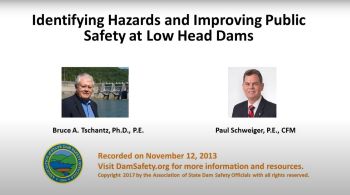Public Safety: Difference between revisions
No edit summary |
No edit summary |
||
| (10 intermediate revisions by 2 users not shown) | |||
| Line 9: | Line 9: | ||
<!-- Delete any sections that are not necessary to your topic. Add pictures/sections as needed --> | <!-- Delete any sections that are not necessary to your topic. Add pictures/sections as needed --> | ||
Conditions may exist at or near dams and hydraulic structures | Conditions may exist at or near dams and hydraulic structures that could cause injury or loss of life. Although the most significant hazard and cause of fatalities is the transient submerged hydraulic jump or [[Hydraulic Roller|hydraulic roller]] that is often attributed to flow over low-head run-of-the-river dams, there are many other hazards that exist at dams that have contributed to accidents and fatalities. Dozens of fatalities, resulting from other hazardous conditions produced by and around dams include: strainers, sudden releases with rapidly increasing flow conditions, [[Confined Spaces|confined spaces]], unpredictable currents, submerged structures, hidden dam crests, watercraft over [[spillways]], entrapment, stranding, and steep slopes and [[Slippery Surfaces|slippery surfaces]]. | ||
Dam owners, engineers inspecting and designing dam modifications, regulators and others working around dams need to understand the hazards posed to the public by the presence and operations of dams and levees and be aware of their responsibility for addressing, managing, and when possible eliminating these public safety risks. | |||
When possible, hazards should be completely mitigated by modifying a dam to completely eliminate the risk to the public. When not possible, mitigation measures can include restrictions to entry (fencing) and signage. Public safety education particularly with young people is another strategy to prevent deaths or injuries at these dams. | |||
* [[Legal Responsibilities (Public Safety)]] | * [[Legal Responsibilities (Public Safety)]] | ||
| Line 18: | Line 22: | ||
==Examples== | ==Examples== | ||
{{Website Icon}} [https://damfailures.org/lessons-learned/public-safety-at-dams/ Learn more about the need to address public safety at dams at DamFailures.org] | {{Website Icon}} [https://damfailures.org/lessons-learned/public-safety-at-dams/ Learn more about the need to address public safety at dams at DamFailures.org] | ||
==Best Practices Resources== | ==Best Practices Resources== | ||
{{Document Icon}} [[Dam Safety Warning Signs Best Practices (FEMA P-2188)|Dam Safety Warning Signs Best Practices ( | {{Document Icon}} [[Dam Safety Warning Signs Best Practices (FEMA P-2188) | Dam Safety Warning Signs Best Practices (FEMA P-2188), FEMA]] | ||
{{Document Icon}} [[Guidelines for Public Safety at Hydropower Projects|Guidelines for Public Safety at Hydropower Projects | {{Document Icon}} [[Guidelines for Public Safety at Hydropower Projects | Guidelines for Public Safety at Hydropower Projects, FERC]] | ||
==Trainings== | ==Trainings== | ||
| Line 29: | Line 34: | ||
<!-- For information on notation for in text citations visit https://www.mediawiki.org/wiki/Help:Cite Or simply enclose the citation as shown <ref> citation </ref> in the location of the in text mention. Citations will automatically populate below--> | <!-- For information on notation for in text citations visit https://www.mediawiki.org/wiki/Help:Cite Or simply enclose the citation as shown <ref> citation </ref> in the location of the in text mention. Citations will automatically populate below--> | ||
{{Citations}} | {{Citations}} | ||
<!-- Revision history information --> | <!-- Revision history information --> | ||
{{revhistinf}} | {{revhistinf}} | ||
Latest revision as of 20:14, 11 July 2023

|
| Learn more about public safety at dams from this free webinar |
Conditions may exist at or near dams and hydraulic structures that could cause injury or loss of life. Although the most significant hazard and cause of fatalities is the transient submerged hydraulic jump or hydraulic roller that is often attributed to flow over low-head run-of-the-river dams, there are many other hazards that exist at dams that have contributed to accidents and fatalities. Dozens of fatalities, resulting from other hazardous conditions produced by and around dams include: strainers, sudden releases with rapidly increasing flow conditions, confined spaces, unpredictable currents, submerged structures, hidden dam crests, watercraft over spillways, entrapment, stranding, and steep slopes and slippery surfaces.
Dam owners, engineers inspecting and designing dam modifications, regulators and others working around dams need to understand the hazards posed to the public by the presence and operations of dams and levees and be aware of their responsibility for addressing, managing, and when possible eliminating these public safety risks.
When possible, hazards should be completely mitigated by modifying a dam to completely eliminate the risk to the public. When not possible, mitigation measures can include restrictions to entry (fencing) and signage. Public safety education particularly with young people is another strategy to prevent deaths or injuries at these dams.
- Legal Responsibilities (Public Safety)
- Risk Assessment (Public Safety)
- Risk Mitigation (Public Safety)
- Public Safety Program Management
Examples
![]() Learn more about the need to address public safety at dams at DamFailures.org
Learn more about the need to address public safety at dams at DamFailures.org
Best Practices Resources
![]() Dam Safety Warning Signs Best Practices (FEMA P-2188), FEMA
Dam Safety Warning Signs Best Practices (FEMA P-2188), FEMA
![]() Guidelines for Public Safety at Hydropower Projects, FERC
Guidelines for Public Safety at Hydropower Projects, FERC
Trainings
![]() On-Demand Webinar: Introduction to Public Safety Risk Evaluation and Treatment for Dams and Levees
On-Demand Webinar: Introduction to Public Safety Risk Evaluation and Treatment for Dams and Levees
![]() On-Demand Webinar: Identifying Hazards and Improving Public Safety at Low Head Dams
On-Demand Webinar: Identifying Hazards and Improving Public Safety at Low Head Dams
![]() YouTube: Identifying Hazards and Improving Public Safety at Low Head Dams
YouTube: Identifying Hazards and Improving Public Safety at Low Head Dams
Citations:
Revision ID: 7152
Revision Date: 07/11/2023
